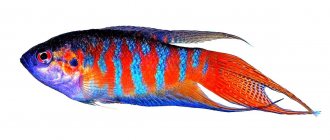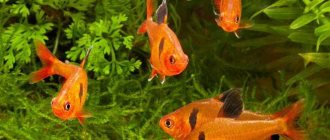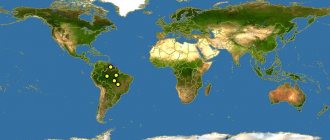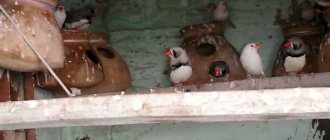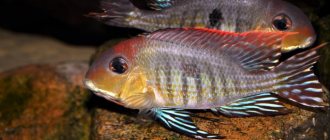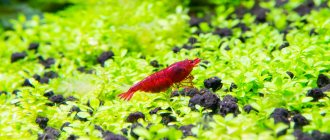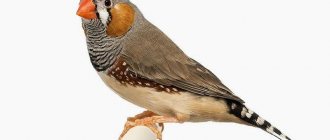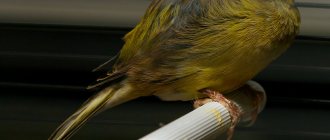Duckweed is a perennial plant belonging to the araceae family. The plant has several other names, namely, frog sack, bayruta. Duckweed is a small, floating species of plant. A distinctive feature lies primarily in the fact that this species is considered the smallest among flowering algae throughout the world. Under natural conditions, it can be found in almost all open bodies of water where the water is stationary - swamps, ponds, lakes. If the plant grows and covers the entire surface of the water, then large fish will die from oxygen deficiency.
The benefits and harms of duckweed for an aquarium
For the inhabitants to live a full life in an aquarium, the presence of algae and plants is required. Duckweed growing in an aquarium has a number of qualities. In addition, breeding does not require much effort.
When considering the benefits or harms of duckweed in an aquarium, it is worth noting a number of advantages:
- Duckweed is a natural plant food for many species of fish. As a rule, goldfish prefer it.
- If necessary, you can add it to a container of water that is intended for water changes. In this case, the plant brings double benefits - food and aeration.
- The excess can be dried at home and then added to other dry foods.
- Fry and larvae hide in the thickets of plants.
Despite all the advantages, there are also some disadvantages:
- The appearance is not particularly attractive.
- Duckweed grass grows on the surface of the water, thereby reducing the amount of lighting for aquarium inhabitants.
Before purchasing duckweed, it is recommended to first study all the available features.
Beneficial and medicinal properties in other areas, application
Duckweed has found wide application in various fields:
- In agriculture. A nutritional supplement for poultry and livestock feed in the spring and as a fertilizer for plants.
- In traditional and home medicine. They use its medicinal and healing properties.
- Cleaning water bodies. It has the ability to process heavy substances that are discharged by industrial enterprises.
- To characterize water bodies. Allows you to detect harmful substances. If there is an excess of chlorine, it turns yellow and disappears.
- Used as food in tropical countries and as a seasoning in cooking.
This variety of uses is explained by useful substances; Duckweed includes:
- aspartic and glutamic acid;
- carbohydrates;
- vitamins B, PP, A and E;
- amino acids (arginine and lysine);
- trace elements (bromine, calcium, iodine, silicon and others);
- flavonoids and triterpenes.
Due to its high protein content, Duckweed is called “water lentil”. Its nutritional values are the same as those of cultivated cereal grains. Duckweed is used to treat animals and humans, producing various medicines:
- pills;
- juice;
- decoction;
- tinctures.
Here are some recipes for using Duckweed:
- Moisten the affected areas of the skin with the infusion and gargle for sore throat. Treat bronchitis and psoriasis by taking it orally.
- Compresses are made based on decoctions, which helps reduce inflammation, swelling and pain, and itching from insect bites.
- The tincture is instilled into the eyes for glaucoma, into the nose for a runny nose.
- The powder is taken orally as a cleanser for diathesis and allergic rashes. By mixing it with honey, vitiligo, rheumatism, and impotence are treated.
- A mixture with burdock seeds is used for nephritis.
- Alcohol tincture helps with allergies, as an analgesic and anthelmintic.
- Ointment with Duckweed treats joint diseases and skin rashes.
In folk medicine, duck grass is used to treat asthma and is used to reduce pain from hemorrhoids and metabolic disorders. Recently, scientists have found that it contains an anti-carcinogenic component, which gives a stable antimutagenic effect. This allows duckweed to be used in the treatment of cancer patients. The drug “Vitilem +” was created for the treatment of vitiligo.
General recommendations for use: all recipes give a positive effect if you follow the instructions. The medications must be taken for a certain period of time and only after consultation with your doctor.
There are a number of contraindications (individual intolerance and vegetative-vascular dystonia), which can cause nervous overexcitation. To prepare preparations from Duckweed at home, you can purchase it in a pharmacy in dried form.
Varieties of duckweed
In nature, there are about 10 species of duckweed. If we consider the most popular varieties, we can distinguish only 3 varieties.
Lesser duckweed is the most common species and is most often found in home aquariums. Most often it is called swamp.
Duckweed trilobed – grows in the water column and rises to the surface of the water only during the flowering period. It grows quite quickly and is excellent for spawning.
Small duckweed lemna minor
Small duckweed is a floating type of plant. the size varies from 1.5 to 3.5 mm in the crossbar. The plant consists of a round or oval thallus, which is both a leaf and a stem. Due to the fact that there are a large number of air bubbles in the thallus, the plant remains on the surface of the water. The upper part is green, the lower part is light green. In some cases, which happens extremely rarely, a bud appears, the size of which practically does not exceed 1 mm.
Duckweed lemna gibba
Humpbacked duckweed is another species that is much less common in aquarium conditions. The size of the root system is 15 cm in length. The leaf plates float on the surface of the water, in some cases acquiring a reddish tint. The shape of the leaves is ovoid or round.
Botanical description and natural habitat
Duckweed (Lemna) belongs to the Araceae family. It is a perennial aquatic monocotyledonous plant, except for one species - tropical. The name comes from the Russian word ryasy, which meant beads. These are microscopic plants that move on the surface of stagnant waters and form real settlements. They are classified as plankton. They are found in nature in swamps, lakes, natural and decorative ponds and do not live in fast river water. The growth rate is high, it is quite difficult to remove, so there is a comparison with weeds. It will not be possible to divide Duckweed into a leaf and a stem. Its body looks like an oval or elongated plate (leaf); at the bottom there may or may not be an almost transparent root, on the side there are branches that grow and separate. This is how reproduction occurs.
Photo gallery of Duckweed:
Veins (5-7) with a number of air sinuses (1-2) and a barely noticeable root help the plant to stay on the water. The plates are pale greenish in color, dense. Their bottoms are smooth, shiny, yellow or white, sometimes with red splashes. Small, inconspicuous flowers, usually light or lemon, appear quite rarely. The fruit resembles a bag in appearance; its seed ripens inside, but with its help Duckweed does not reproduce.
The optimal temperature for development is +20…+28 °C, but can grow at +6…+33 °C. A distinctive feature is that it survives at low temperatures, under ice.
The entire plant may freeze, but it will form viable buds (turion buds), which will begin a new development cycle in the spring. It tolerates unfavorable conditions at the bottom of the reservoir, where it sinks due to the high starch content. It has received popular nicknames “frog sack” and “duck grass” because waterfowl love to eat it.
Duckweed can be found in almost all countries of the world, except the Arctic. It prefers warm and humid climates, but also grows in the temperate zone. She ended up there thanks to birds and animals, sticking to their limbs and thus moving over long distances.
Duckweed propagation method
Duckweed in an aquarium multiplies at a rapid rate. Literally a few days or a week will pass, and the entire surface of the water will be covered with this type of plant.
For propagation, it is recommended to provide a sufficient level of lighting. If the lighting is dim and the daylight hours are short, the plant will begin to turn white after a while, after which it dies.
The best option is to grow duckweed in a separate aquarium or container, this is especially true if the plants are planned to be used as fish food in the future.
Hey, are you up there? A little about surface plants
For many, the first thing that comes to mind is duckweed and swampweed, so familiar to us from natural sources.
They are sometimes confused by “dummies” with algae. Speaking scientifically, the group of plants that grow on the surface of the aquarium includes many species from the Pontederiaceae family, as well as Salviniaceae. What characterizes these plant species? And the fact is that they have some structural features that provide them with a comfortable stay in an aquarium without soil. They are prevented from sinking to the bottom by the air, which is concentrated in the petioles and leaf-like stems, namely in special “plant containers” - containers and planes.
It is this feature that is decisive for plants that prefer to always be “on top.” To better understand this, let's look at the example of Salvinia eared. It is no wonder that it comes from the Salvinia family. This plant has paired leaves, convex in shape. They touch the water only with their edges, and thanks to the curved veins, there are pads with air under the leaf. They allow Salvinia eared to stay at the top.
How to breed
Since this plant is more than unpretentious, nothing special needs to be done to maintain it. But the seedling greens that you buy at a pet market or pet store were probably collected from the nearest body of standing water. And you can’t bring it into the aquarium without a two-week quarantine. There is a high risk of introducing mollusks, bacteria and other living creatures, for example, hydra, which will upset the eco-balance in your aquatic kingdom.
For duckweed to grow, a minimum illumination of 0.5–0.8 W/l is required - and nothing more. If your plant looks lethargic and does not reproduce well, this is a sure sign that the water is very poorly saturated with nutrients, so it is necessary to fertilize it.
How to remove duckweed from a pond?
The bayruta mass can increase in size every two or three days under optimal conditions during the summer. This leads to darkening of the underwater flora of your pond.
Cane can be introduced into garden pools unknowingly, brought with recently acquired aquatic plants. Therefore, it is good practice to quarantine purchases for several weeks before introducing them. The algae can also be carried on the feet of waterfowl.
Complete control is not possible. Growth must be controlled before it becomes too widespread. To do this, try the following measures:
- On smaller bodies of water, a rotating rake or net will keep the sacks under control.
- Install stop boards at upstream entrances to prevent duckweed from entering ponds or lakes.
- Algae-eating birds such as domestic and ornamental ducks, moorhens and coops will provide some degree of control of the species.
- Grass carp will also feed on sackwood.
- Shading reduces duckweed growth. This is achieved by planting on the south side of the pond. Water lilies and other plants with floating leaves can also significantly reduce duckweed levels.
